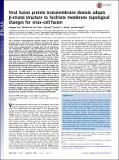Viral fusion protein transmembrane domain adopts β-strand structure to facilitate membrane topological changes for virus–cell fusion
Author(s)
Yao, Hongwei; Lee, Michelle W.; Waring, Alan J.; Wong, Gerard C. L.; Hong, Mei
DownloadYao-2015-Viral fusion protein.pdf (1.549Mb)
PUBLISHER_POLICY
Publisher Policy
Article is made available in accordance with the publisher's policy and may be subject to US copyright law. Please refer to the publisher's site for terms of use.
Terms of use
Metadata
Show full item recordAbstract
The C-terminal transmembrane domain (TMD) of viral fusion proteins such as HIV gp41 and influenza hemagglutinin (HA) is traditionally viewed as a passive α-helical anchor of the protein to the virus envelope during its merger with the cell membrane. The conformation, dynamics, and lipid interaction of these fusion protein TMDs have so far eluded high-resolution structure characterization because of their highly hydrophobic nature. Using magic-angle-spinning solid-state NMR spectroscopy, we show that the TMD of the parainfluenza virus 5 (PIV5) fusion protein adopts lipid-dependent conformations and interactions with the membrane and water. In phosphatidylcholine (PC) and phosphatidylglycerol (PG) membranes, the TMD is predominantly α-helical, but in phosphatidylethanolamine (PE) membranes, the TMD changes significantly to the β-strand conformation. Measured order parameters indicate that the strand segments are immobilized and thus oligomerized. [superscript 31]P NMR spectra and small-angle X-ray scattering (SAXS) data show that this β-strand–rich conformation converts the PE membrane to a bicontinuous cubic phase, which is rich in negative Gaussian curvature that is characteristic of hemifusion intermediates and fusion pores. [superscript 1]H-[superscript 31]P 2D correlation spectra and [superscript 2]H spectra show that the PE membrane with or without the TMD is much less hydrated than PC and PG membranes, suggesting that the TMD works with the natural dehydration tendency of PE to facilitate membrane merger. These results suggest a new viral-fusion model in which the TMD actively promotes membrane topological changes during fusion using the β-strand as the fusogenic conformation.
Date issued
2015-09Department
Massachusetts Institute of Technology. Department of ChemistryJournal
Proceedings of the National Academy of Sciences
Publisher
National Academy of Sciences (U.S.)
Citation
Yao, Hongwei, Michelle W. Lee, Alan J. Waring, Gerard C. L. Wong, and Mei Hong. “Viral Fusion Protein Transmembrane Domain Adopts β-Strand Structure to Facilitate Membrane Topological Changes for Virus–cell Fusion.” Proc Natl Acad Sci USA 112, no. 35 (August 17, 2015): 10926–10931.
Version: Final published version
ISSN
0027-8424
1091-6490